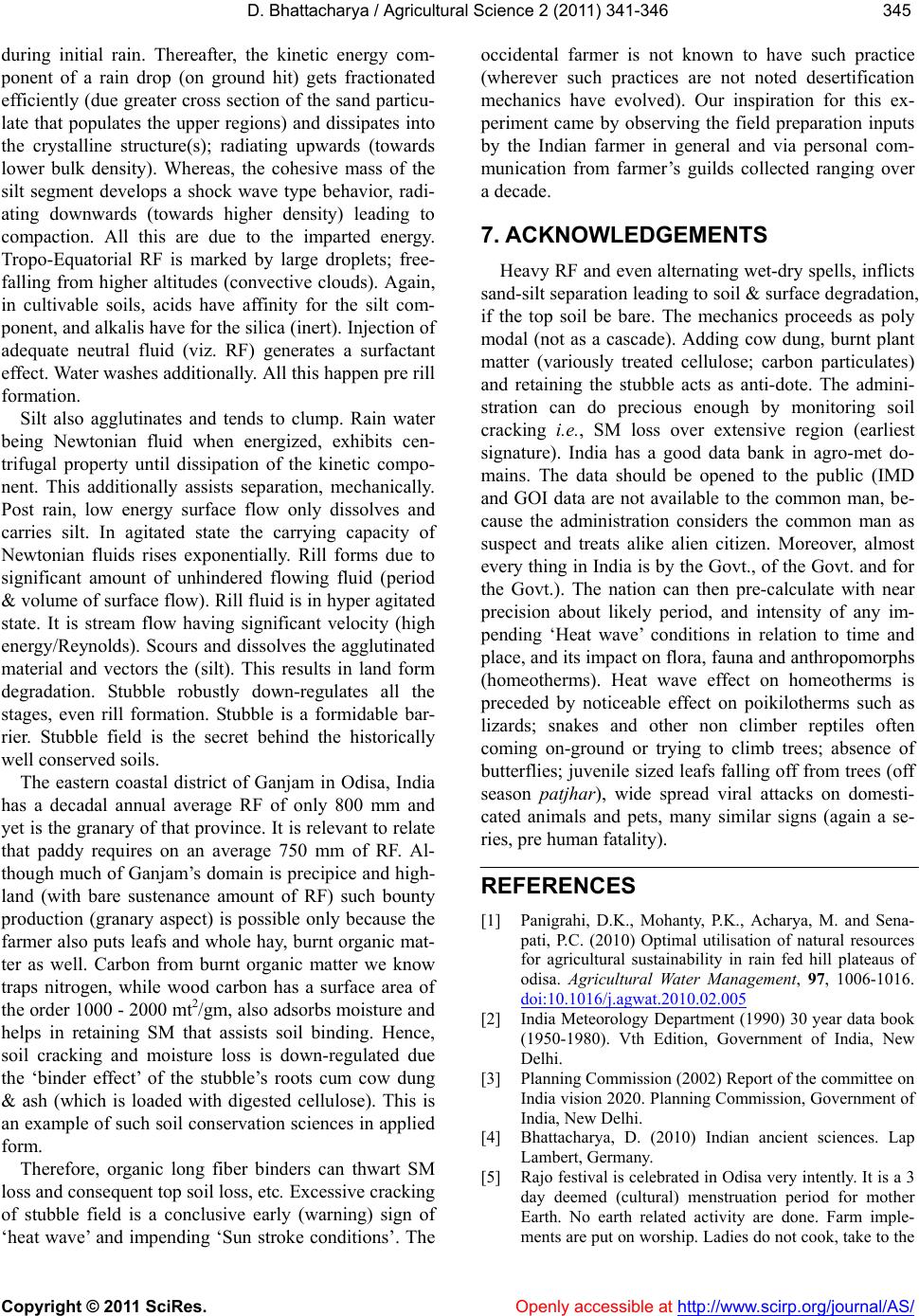
D. Bhattacharya / Agricultural Science 2 (2011) 341-346
Copyright © 2011 SciRes. Openly accessible at http://www.scirp.org/journal/AS/
345345
during initial rain. Thereafter, the kinetic energy com-
ponent of a rain drop (on ground hit) gets fractionated
efficiently (due greater cross section of the sand particu-
late that populates the upper regions) and dissipates into
the crystalline structure(s); radiating upwards (towards
lower bulk density). Whereas, the cohesive mass of the
silt segment develops a shock wave type behavior, radi-
ating downwards (towards higher density) leading to
compaction. All this are due to the imparted energy.
Tropo-Equatorial RF is marked by large droplets; free-
falling from higher altitudes (convective clouds). Again,
in cultivable soils, acids have affinity for the silt com-
ponent, and alkalis have for the silica (inert). Injection of
adequate neutral fluid (viz. RF) generates a surfactant
effect. Water washes additionally. All this happen pre rill
formation.
Silt also agglutinates and tends to clump. Rain water
being Newtonian fluid when energized, exhibits cen-
trifugal property until dissipation of the kinetic compo-
nent. This additionally assists separation, mechanically.
Post rain, low energy surface flow only dissolves and
carries silt. In agitated state the carrying capacity of
Newtonian fluids rises exponentially. Rill forms due to
significant amount of unhindered flowing fluid (period
& volume of surface flow). Rill fluid is in hyper agitated
state. It is stream flow having significant velocity (high
energy/Reynolds). Scours and dissolves the agglutinated
material and vectors the (silt). This results in land form
degradation. Stubble robustly down-regulates all the
stages, even rill formation. Stubble is a formidable bar-
rier. Stubble field is the secret behind the historically
well conserved soils.
The eastern coastal district of Ganjam in Odisa, India
has a decadal annual average RF of only 800 mm and
yet is the granary of that province. It is relevant to relate
that paddy requires on an average 750 mm of RF. Al-
though much of Ganjam’s domain is precipice and high-
land (with bare sustenance amount of RF) such bounty
production (granary aspect) is possible only because the
farmer also puts leafs and whole hay, burnt organic mat-
ter as well. Carbon from burnt organic matter we know
traps nitrogen, while wood carbon has a surface area of
the order 1000 - 2000 mt2/gm, also adsorbs moisture and
helps in retaining SM that assists soil binding. Hence,
soil cracking and moisture loss is down-regulated due
the ‘binder effect’ of the stubble’s roots cum cow dung
& ash (which is loaded with digested cellulose). This is
an example of such soil conservation sciences in applied
form.
Therefore, organic long fiber binders can thwart SM
loss and consequent top soil loss, etc. Excessive cracking
of stubble field is a conclusive early (warning) sign of
‘heat wave’ and impending ‘Sun stroke conditions’. The
occidental farmer is not known to have such practice
(wherever such practices are not noted desertification
mechanics have evolved). Our inspiration for this ex-
periment came by observing the field preparation inputs
by the Indian farmer in general and via personal com-
munication from farmer’s guilds collected ranging over
a decade.
7. ACKNOWLEDGEMENTS
Heavy RF and even alternating wet-dry spells, inflicts
sand-silt separation leading to soil & surface degradation,
if the top soil be bare. The mechanics proceeds as poly
modal (not as a cascade). Adding cow dung, burnt plant
matter (variously treated cellulose; carbon particulates)
and retaining the stubble acts as anti-dote. The admini-
stration can do precious enough by monitoring soil
cracking i.e., SM loss over extensive region (earliest
signature). India has a good data bank in agro-met do-
mains. The data should be opened to the public (IMD
and GOI data are not available to the common man, be-
cause the administration considers the common man as
suspect and treats alike alien citizen. Moreover, almost
every thing in India is by the Govt., of the Govt. and for
the Govt.). The nation can then pre-calculate with near
precision about likely period, and intensity of any im-
pending ‘Heat wave’ conditions in relation to time and
place, and its impact on flora, fauna and anthropomorphs
(homeotherms). Heat wave effect on homeotherms is
preceded by noticeable effect on poikilotherms such as
lizards; snakes and other non climber reptiles often
coming on-ground or trying to climb trees; absence of
butterflies; juvenile sized leafs falling off from trees (off
season patjhar), wide spread viral attacks on domesti-
cated animals and pets, many similar signs (again a se-
ries, pre human fatality).
REFERENCES
[1] Panigrahi, D.K., Mohanty, P.K., Acharya, M. and Sena-
pati, P.C. (2010) Optimal utilisation of natural resources
for agricultural sustainability in rain fed hill plateaus of
odisa. Agricultural Water Management, 97, 1006-1016.
doi:10.1016/j.agwat.2010.02.005
[2] India Meteorology Department (1990) 30 year data book
(1950-1980). Vth Edition, Government of India, New
Delhi.
[3] Planning Commission (2002) Report of the committee on
India vision 2020. Planning Commission, Government of
India, New Delhi.
[4] Bhattacharya, D. (2010) Indian ancient sciences. Lap
Lambert, Germany.
[5] Rajo festival is celebrated in Odisa very intently. It is a 3
day deemed (cultural) menstruation period for mother
Earth. No earth related activity are done. Farm imple-
ments are put on worship. Ladies do not cook, take to the